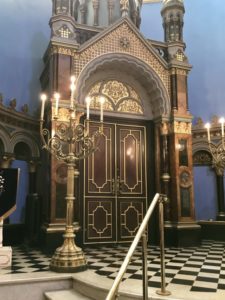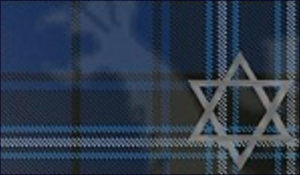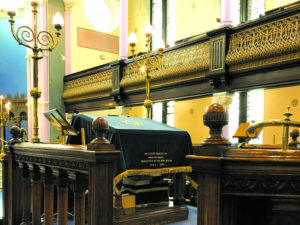 Jews have been living in Scotland since the end of the eighteenth century. The first community was founded in Edinburgh in 1816. The modern community in Scotland is mainly derived from Eastern European immigration from 1891 to 1914.
Jews have been living in Scotland since the end of the eighteenth century. The first community was founded in Edinburgh in 1816. The modern community in Scotland is mainly derived from Eastern European immigration from 1891 to 1914.
The Garnethill Synagogue in Glasgow, which serves the largest Jewish community in Scotland was built in 1879 and was the first purpose-built shul in Scotland.
 By 1914 there were about ten thousand Jews in Glasgow and about 1,500 in Edinburgh, with smaller communities in Dundee and Aberdeen, as well as scattered groups throughout Scotland.
By 1914 there were about ten thousand Jews in Glasgow and about 1,500 in Edinburgh, with smaller communities in Dundee and Aberdeen, as well as scattered groups throughout Scotland.
The Jewish community in Scotland numbered eighteen thousand in the 1950s but has now shrunk to around ten thousand, largely through emigration. The community is overwhelmingly concentrated in the Greater Glasgow area with around a thousand Jews in Edinburgh and smaller numbers scattered around the country.
 In 2008, the first Jewish tartan, the Shalom Tartan was created, which was followed shortly thereafter by a tartan designed by Rabbi Mendel Jacobs and Brian Wilton of the Scottish Tartans Authority. Both Rabbi Jacob’s tartan and the Shalom Tartan consist only of wool, in accordance to Jewish law.
In 2008, the first Jewish tartan, the Shalom Tartan was created, which was followed shortly thereafter by a tartan designed by Rabbi Mendel Jacobs and Brian Wilton of the Scottish Tartans Authority. Both Rabbi Jacob’s tartan and the Shalom Tartan consist only of wool, in accordance to Jewish law.
Despite its proud history and vibrant community, the Jews of Scotland have felt more insecure in recent years.
 Many younger Jews have left; the community is now estimated at 7,000-8,000, with most Scottish Jews living in Glasgow. Only one Jewish school remains in the entire country. Today, in addition to Glasgow, there are Jewish communities in Aberdeen, Ayr, Dundee, Dunfermline, Edinburgh, Falkirk, Greenock and Inverness.
Many younger Jews have left; the community is now estimated at 7,000-8,000, with most Scottish Jews living in Glasgow. Only one Jewish school remains in the entire country. Today, in addition to Glasgow, there are Jewish communities in Aberdeen, Ayr, Dundee, Dunfermline, Edinburgh, Falkirk, Greenock and Inverness.
Glasgow boasts six synagogues, a primary school, two nursing homes and supportive housing for the elderly, a welfare center, a golf club, a sports centre, a community newspaper, youth groups and a delicatessen.